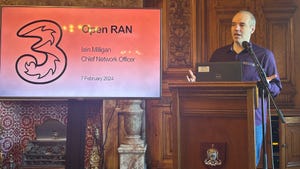AT&T Opens Silicon Valley Developer Den
AT&T's Foundry program, which encourages app development on its network, opens a Silicon Valley location in hopes of attracting more partners
September 14, 2011

PALO ALTO, Calif. -- AT&T Inc. (NYSE: T) officially opened the doors to its Silicon Valley developer-outreach operation here Wednesday, ostensibly to help accelerate the arrival of cool devices and applications for its networks. Though few actual developers were in attendance, AT&T said its potential field of dreams is already attracting startup attention, via established venture capital channels as well as from individuals with great ideas, who come seeking the help the big carrier can provide.
According to AT&T chief technical officer John Donovan, AT&T already has 106 projects underway in its Foundry program, with a goal of moving ideas to usable products and applications quickly.
“There are not demo centers,” said Donovan in his remarks that officially opened AT&T’s Palo Alto digs. “This [place] is about where the work gets done. And this is our capstone facility [in the Foundry program] because of where it’s located and the intensity around it.” The Foundry is located just south of downtown in this nexus of venture capital, where startup smarts and the Silicon Valley tech buzz are never in short supply. (See From AT&T Labs: A New(er) Network Vision.)
Courting developers is the new black for service providers, especially so in this region where competitors Verizon Wireless and Sprint Corp. (NYSE: S) already have similar developer-outreach centers open. AT&T’s physical space, like the others, is configured for maximum flexibility, with open floor plans, rolling walls and other infrastructure goodies that allow for on-the-fly meetings, technical installs and even video conferences via a dedicated video-conference room.
And though the proximity to the startup and Internet scene may be part of a lure, developers on hand Wednesday said that AT&T’s newfound flexibility in adapting its practices, technologies and accessibility may end up being the most attractive parts of the Foundry operation. Travis Bogard, VP of product management and strategy for cellphone accessory maker Jawbone, has been impressed by Ma Bell’s new willingness to transform its network APIs to make it easier for developers like Jawbone to get new products out the door.
“Often APIs [from large carriers] have been fixed -- but in the Foundry program we’ve found AT&T really collaborating with us to change APIs and what they look like,” said Bogard, whose company was showing a prototype health-monitoring wristband that may come to market sooner with AT&T’s help. Though Jawbone intends to offer its products to different provider networks, Bogard said having a local and willing partner in AT&T has already sped up the launch process.
According to Donovan, AT&T is not looking to take a financial stake in any of the Foundry partners -- instead it’s all about trying to make AT&T the favored network for cool new stuff, which he said will pay off by increasing the numbers of satisfied customers and partners.
“In a subtle but profound way, we want to be the preferred network for innovation,” said Donovan. “Our job is to find the projects and developers, and give them the tools they need to accelerate their product life cycle.”
Though Donovan said AT&T is working with local venture capitalists to find promising startups -- “They [the VCs] are an excellent screening mechanism” -- he also said AT&T has what it calls “scouts,” employees who go out searching for innovation wherever it can be found, including two 20-year-old students from Georgia Tech who presented their idea to AT&T execs at the Palo Alto Foundry earlier this week.
“They were what you expect, nervous college students who want to change the world,” Donovan said. “But why would you say no to enthusiastic people like that?”
Håkan Eriksson, CTO and head of Silicon Valley operations for AT&T’s partner, Ericsson AB (Nasdaq: ERIC) (which helped fund the Palo Alto Foundry), said the space was important to help accelerate development for devices and applications on the network that has Ericsson gear in its core.
“This is the place to meet the right people, and use the right technology. Then you can see if your idea works, and if anyone is interested in it,” Ericksson said. “Then demos can become betas, and betas can become products.”
For more
AT&T's Dapper Den for App Developers
AT&T Opens Foundry in Israel
Verizon Rallies Developers for LTE
— Paul Kapustka is the founder and editor of Sidecut Reports, a Wireless analysis site and research service. He can be reached at [email protected]. Special to Light Reading.
You May Also Like
.jpg?width=300&auto=webp&quality=80&disable=upscale)









